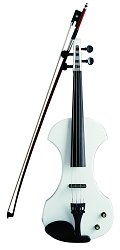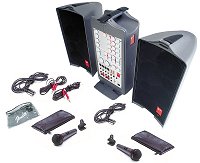|
|
| |
|
|
| |
      


The P-250 is an ideal solution for larger applications (from approximately
300 - 500 people in size):
| 53 lbs. |
| 250 watts (125 per channel) stereo with digital reverb
|
| Four mic/ line inputs |
| Two mono/stereo inputs |
| AC or DC power operable |
| Two P-51 microphones (with stand clips, speaker cables and individual
carrying pouches) |

|
MANUEL
RODRIGUEZ CLASSICAL GUITARS
GUITARRAS MANUEL
RODRIGUEZ, S.A. LUTHIERS
|
Grandson
of Manuel Rodriguez Maregui, a flamenco guitar player of the last century
and son of Manuel Rodriguez Perez, himself a make of classical guitars,
Manuel Rodriguez learned the art of constructing a guitar first-hand.
Using only the finest woods, and hand forming the sides of each guitar to
precise tolerances, Manuel Rodriguez developed distinctive guitars fit for
the world's finest artists.
As
always, Manuel Rodriguez and his sons put a part of themselves into every
guitar they construct, for each is as unique and individual as the
musician who plays it. For those with time and patience, Manuel Rodriguez
Sr. still produces a very limited number of guitars each year. Each guitar
built by Manuel Rodriguez Sr. is truly a masterpiece that reflects the
experience and craftsmanship embodied by the master himself - each guitar
is a work of art to be treasured for generations.
Rodriguez guitars are built in Spain by the Manuel Rodriguez company and
distributed exclusively in North America by Fender Musical Instruments
Corporation.
|
The
history of Rodriguez guitars is as rich as the woodsy Fender Musical
Instruments Corporation. |
|
IN STOCK NOW
-MARCH 1999 GUITAR PLAYER-
|
By Darrin Fox
|

PHOTOS: PAUL HAGGARD
Lets
face it, sometimes you just want to be loud. Many guitarists find great joy
in wreaking havoc with raw power and, for decades, Marshall has satisfied
the craving. Fender's resurrection of the Sunn name-and its introduction of
the radically re-designed Model T amp-are clear signs that the Arizona-based
company wants a piece of the action. Smart move. While "crushing distortion"
and "Fender" are seldom uttered in the same sentence, the new 100-watt Sunn
Model T ($1,299) and its companion 4x12 speaker enclosure ($699; with
Celestion G12 T-75 speakers) give Fender a magnum weapon for the truly power
mad.
I put the Model T half-stack through its paces using a Fender American
Standard Strat, a '62 reissue Tele Custom, a '61 Les Paul Jr., and a PRS
McCarty.
|
|
Sunn Setting
The Model T is simple to navigate. Channel 1 offers volume, treble, bass,
and mid controls, and channel 2 sports volume, gain, treble, bass, and mids.
Both channels share a single
presence
knob. The rear panel includes an "Arena/Club" switch (more on this later), a
1/4" main amp output (for routing the preamp signal to another amplifier), a
1/4" external amp input (which allows the Model T's output stage to be
driven by an external preamp), an XLR line out, an extension speaker jack,
and an impedance selector (4, 8, 16).
The all-tube effects loop features separate send and return jacks for each
channel, as well as independent send and return level controls for each
loop. The loop can be bypassed using the on/off switch or the supplied
2-button footswitch. The rear panel also sports bias and balance trim pots,
and three test-points to insert a digital voltmeter (not included) for bias
readings.
Rear-panel warning LEDs monitor current flow to each pair of power tubes. If
the LEDs are green, everything's cool. A red LED indicates improper current
draw, at which point the failed tube is automatically switched out of the
circuit and the power is cut to 50 watts (or 12.5 watts if you're operating
in Club mode). A cool, gig-saving feature!

Sunn Burn
The Model T is definitely a "plug in and go" amplifier. Channel 1 delivers
ringing clean tones from either single coils or humbuckers. Turning the
volume full up produces sparkling, detailed textures that are rife with
low-end fullness. The Sunn's clean sounds are way chunkier than traditional
Fender flavors, but not quite as brutish as, say, a 100-watt plexi Marshall.
The Sunn definitely inhabits its own sonic niche. Although channel 2 is the
amp's overdrive channel, its responsiveness to the McCarty's volume control
was amazing-clean, crunch, and full-on shred tones were right at my
fingertips.
The Model T is also loud-very loud-and its bass response is fat, punchy, and
instantaneous. By the time channel 1 began breaking up, my pant legs were
flapping in the breeze. The humbucker-equipped McCarty seriously bullied the
amp's front end, making open-position chords bark like a rabid dog. Malcolm
Young-approved toughness, for sure.
The Model T's EQ is well-voiced and effective. Radical settings produced no
ugly sounds, and the controls allowed for tasteful tweaking, no matter which
guitar I used. Channel 2's mid control provides frothy richness or
scooped-mid death tone, and the treble knob lets you dial in maximum cutting
power without shrillness-its voicing helped complex chord clusters stay
audible, allowing harmonic nuances to shine through, even with high doses of
gain. The shared presence knob is effective for adding sheen to either
channel.

Too Much Sunn?
The Model T's Arena/Club switch drops the power output from 100 to 25 watts,
but unlike some power-reduction schemes, the Sunn's reduces volume without
neutering your tone. Instead of switching power tubes out of the circuit
entirely for those "browner" tones (which can affect tube matching), the
Model T's Club setting lowers the voltage to the four Groove Tubes GT 5881s
via a transformer tap. I love how it softens the Sunn's aggressive attack
while keeping the bass frequencies fat and intact. If you're into the
tactile "squishiness" of lower-powered amplifiers, you'll dig this feature
immensely. It works so well that many players may find themselves living
exclusively in the quarter-power domain.

Under the Sunn
The Model T's construction is tough and tidy. Inside the heavy-duty
folded-steel chassis is a large PC board that grips most of the circuit
components, including the five 12AX7 sockets and the front-panel controls.
Two satellite boards hold the biasing and effects-loop circuitry. The four
output-tube sockets are chassis mounted, as are the two 12AX7s that power
the effects loop. The hefty transformers are a welcome sight-especially the
huge power transformer. Cabinet construction is first rate, and the Tolex
covering is cleanly applied. The side-mounted handles made for rather clumsy
handling, however. The matching 4x12 speaker enclosure is constructed from
11-ply birch plywood and handles 300 watts at 16. Casters are provided.

Sunn Worship
With its powerful tones, excellent power attenuation, and effects-loop
versatility, the Sunn Model T emerges as a hot contender for your hard-rock
bucks. This high-powered, high-gain, all-tube amplifier delivers ungodly
British-flavored blast at a very down-home price. Sunn amps may have never
had the visual allure of Marshalls, but for rock players who aren't hung-up
on a black-and-gold backline, the new Sunn is a very smart choice.
|
|